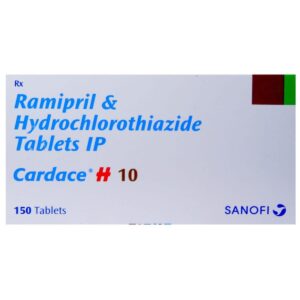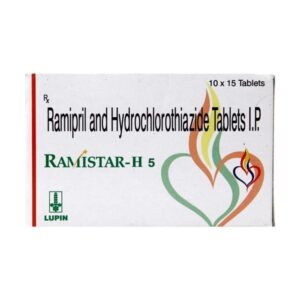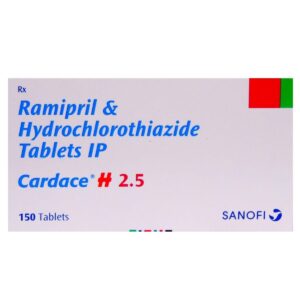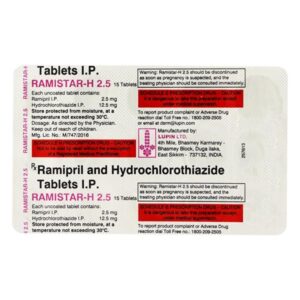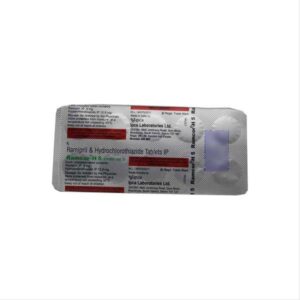HYDROCHLOROTHIAZIDE + RAMIPRIL
Hydrochlorothiazide: Hydrochlorothiazide is a medication that belongs to a class of drugs known as thiazide diuretics. It is primarily used to treat high blood pressure (hypertension) and edema (fluid retention) caused by various conditions such as congestive heart failure, kidney disorders, and liver cirrhosis.
The mechanism of action of hydrochlorothiazide involves increasing the excretion of water and sodium from the body through the kidneys. By reducing the volume of fluid in the bloodstream, it helps lower blood pressure and reduces swelling.
Hydrochlorothiazide is available in tablet form and is usually taken orally once daily. The recommended dose can vary depending on the individual’s condition, but it typically ranges from 12.5 to 50 mg per day. It is important to follow the prescribed dosage and instructions given by a healthcare professional.
Like any medication, hydrochlorothiazide can potentially cause side effects. Common side effects may include dizziness, headache, nausea, increased urination, muscle cramps, and low blood potassium levels (hypokalemia). In rare cases, more serious side effects such as allergic reactions, severe skin reactions, pancreatitis, and liver problems can occur. It is essential to seek medical attention if any severe side effects or allergic reactions are experienced.
It is important to note that hydrochlorothiazide may interact with other medications, such as those used for diabetes, lithium, nonsteroidal anti-inflammatory drugs (NSAIDs), and certain blood pressure medications. It is crucial to inform a healthcare professional about all medications, supplements, and medical conditions before starting hydrochlorothiazide or making any changes to the treatment plan.
Overall, hydrochlorothiazide is an effective medication for managing high blood pressure and edema. However, it should only be used under the guidance and supervision of a healthcare professional.
Ramipril: Ramipril is a medication primarily used in the treatment of hypertension (high blood pressure) and heart failure. It belongs to a class of drugs called ACE inhibitors (angiotensin-converting enzyme inhibitors). ACE inhibitors work by inhibiting the production of an enzyme called angiotensin-converting enzyme, which is responsible for converting angiotensin I into angiotensin II.
Angiotensin II is a powerful vasoconstrictor, meaning it narrows the blood vessels, causing an increase in blood pressure. By inhibiting the production of angiotensin II, ramipril helps to relax and widen the blood vessels, thereby lowering blood pressure. It also helps to reduce the workload on the heart and improve its function in heart failure patients.
The recommended dose of ramipril for hypertension generally starts at 2.5 to 5 mg once daily, which can be increased to a maximum of 10 mg daily if needed. For heart failure, the initial dose is usually lower and titrated gradually under medical supervision.
Common side effects of ramipril include dizziness, headache, cough, gastrointestinal disturbances (such as nausea, vomiting, and diarrhea), fatigue, and skin rash. In some cases, it may also cause a decrease in kidney function or an increase in potassium levels, especially in individuals with pre-existing kidney disease or those taking potassium-sparing diuretics. Therefore, regular monitoring of kidney function and potassium levels is essential in patients taking ramipril.
Rare but serious side effects include angioedema (swelling of the face, lips, tongue, or throat), which may require immediate medical attention. It is also important to note that ramipril should not be used during pregnancy as it could harm the unborn baby.
As with any medication, it is important to consult with a healthcare professional before starting ramipril to ensure it is suitable for your specific medical condition and to discuss any potential drug interactions or contraindications.

